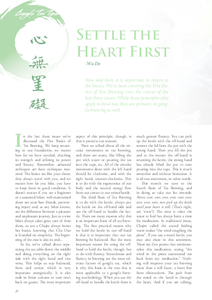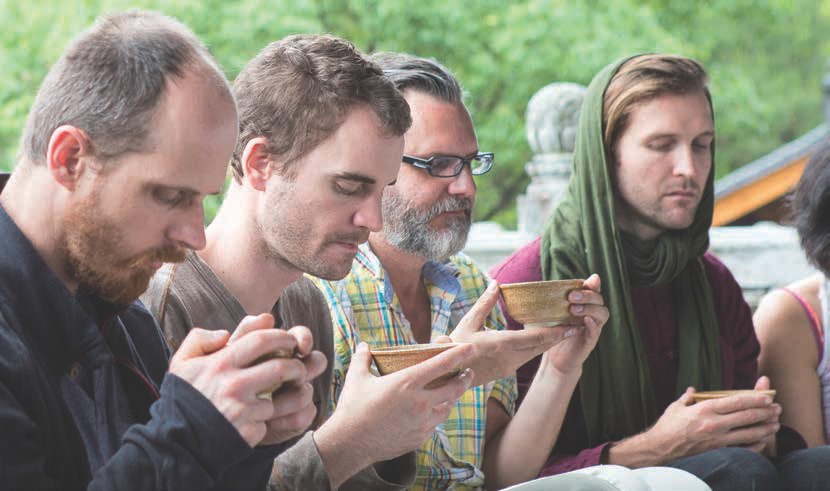
 |
|

In the last three issues we've discussed the Five Basics of Tea Brewing. We keep returning to our foundation, no matter how far we have traveled, checking its strength and refining its power and beauty. Remember, advanced techniques are basic techniques mastered. The basics are like your shoes: they always travel with you, and no matter how far you hike, you have to keep them in good condition. It doesn't matter if you are a beginner or a seasoned hiker; well-maintained shoes are your best friends, preventing injury and, as any hiker knows, are the difference between a pleasant and unpleasant journey. Just as a wise hiker always takes great care of their shoes, so too a Chajin always hones her basics, knowing that Cha Dao is founded on simplicity. The beginning of the enso is also its end...
So far, we've talked about separating the tea table down the middle and doing everything on the right side with the right hand and vice versa. This helps us stay balanced, front and center, which is very important energetically. It is also rude in Asian cultures to turn one's back on guests. The most important aspect of this principle, though, is that it protects our teaware.
Then we talked about all the circular movements in tea brewing, and there are many, like filling the pot with water or pouring the tea into the cups, etc. All of the circular movements done with the left hand should be clockwise, and with the right hand, counter-clockwise. This is to do with the ergonomics of our body and the natural energy flow from our center to our wrists/hands.
The third Basic of Tea Brewing is to do with the kettle: always put the kettle on the off-hand side and use the off-hand to handle the kettle. There are many reasons why this is an important basic of all tea brewing. The first practical reason why we hold the kettle in our off-hand is that it is important that our tea brewing be balanced. But the most important reason for using the offhand to hold the kettle, though, has to do with fluency. Smoothness and fluency in brewing are the most relevant factors of gongfu tea, which is why this basic is the one that is most applicable to a gongfu brewing methodology. When you use the off-hand to handle the kettle there is much greater fluency. You can pick up the kettle with the off-hand and remove the lid from the pot with the strong hand. Then you fill the pot and at the instant the off-hand is returning the kettle, the strong hand has already lifted the pot to start pouring into the cups. This is much smoother and without hesitation. It is all one movement, in other words.
This month we turn to the fourth Basic of Tea Brewing, and in doing so take our list inwards: Never, ever, ever, ever, ever, ever, ever, ever, ever, ever, ever pick up the kettle until your heart is still. (That's right, ten 'evers'!) The time it takes the water to boil has always been a time for meditation. In traditional times, Chajin called the sound boiling water makes "the wind soughing the pines". If you use a metal kettle, you may also share in this sentiment. There are Zen poems that sentimentalize this meditation, saying "the wind in the pines summoned me back from my meditation." Nothing will improve your tea brewing more than a still heart, a heart free from obstructions. The path from the mind to the hand is through the heart. And if you are talking, out loud or in your mind, nothing with mastery, quietude or grace will follow. Instead, you may leave a trail of broken teaware behind you. In order to achieve mastery of gongfu tea, concentration and focus will be needed.

There is a tradition dating back hundreds of years in China that one shouldn't talk while pouring the tea, lest the words pollute the tea. The pours have always been an opportunity for pauses, even in business meetings or casual conversations over tea. In that way, both the host and the guest gather themselves and reflect on the discussion, weighing their responses properly. Then we speak from the heart, and we learn the art of listening well.
There is no more important advice than to take the time to center yourself before you start each brew. Clear your heart and mind. This could happen through meditation, breathing, a prayer or my favorite, which is to connect the kettle to the pot - with one in each hand - while breathing deeply to calm the mind and center one's energy in the heart. As I do this, I can feel when the connection between the water and Tea is clear, through my heart. When the line is clear and the connection is strong and without any interference or static - only then do I raise the kettle. This requires some patience. But remember that there is no hurry. Tea is always about slowing down! There is never any reason to rush, and nothing good will come from it (and talking while you pour, whether outside or in the form of internal dialogue, also results in more broken teaware over time). If you are to prepare tea masterfully, it must be from the place in you that meets the Universe.
When you are resting deep and centered, the tea brewing happens all its own - in a wu wei, to use a pun... Therefore, the more you cultivate yourself, through meditation and other practices, the better tea you'll make. Tea brewing is not something you do, in other words, but rather something you are.
This month, try to make a greater effort to take a pause before each brew to clear your heart. Live without walls of the mind for a second and put yourself into the tea brewing process, as opposed to standing outside and "doing" it. Connect the kettle's handle to the button of your pot and see if you can feel the flow of energy and communication between the tea and the water/heat. It will be easier to feel after the first steeping, as they have already met - there is water in the leaves and pot, in other words. See if you can recognize when the connection is not clear - when it is bumpy/ static as opposed to a smooth flow. What happens when you brew tea with your mind? If you find clarity within and pour from there, how is the tea different? What is the difference in the preparation itself? Where do the guiding principles come from when you aren't there? When there is no sense of 'I' as subject who is 'preparing tea' as verb, who/what is preparing the tea? Where do the movements come from? And where do they go when they are done?
As usual, we are excited to hear about your insights: globalteahut@gmail.com